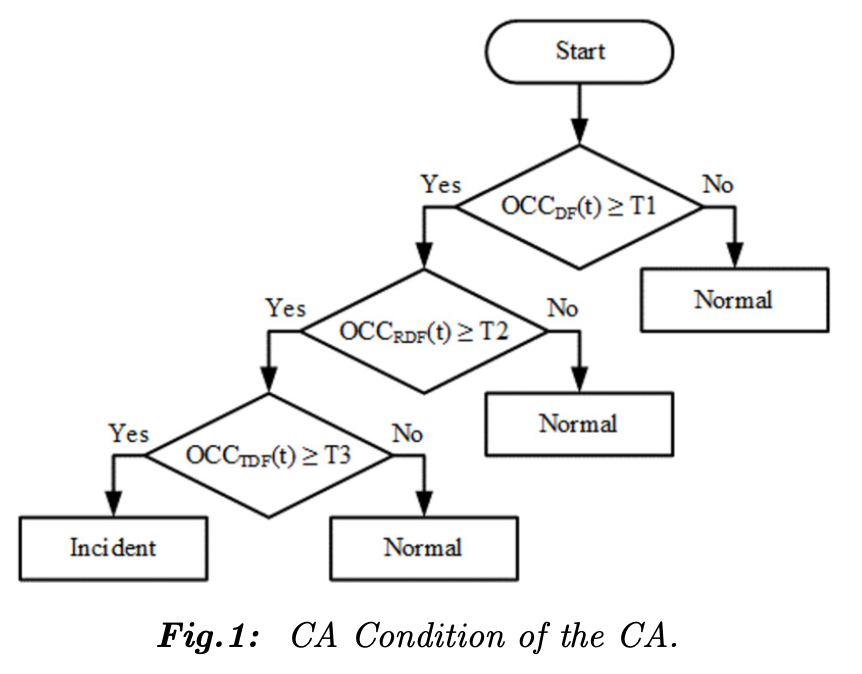Optimizing Incident Detection Thresholds Using the A* Algorithm: An Enhanced Approach for the California Algorithm
Main Article Content
Abstract
This paper presents an improved version of the California Algorithm (CA), focusing on threshold selection criteria. The CA is a widely recognized incidence detection algorithm used as a benchmark for comparison with newly developed incident detection algorithms. This study proposes criteria for threshold selection in CA based on the A* algorithm, which aims to find optimal thresholds using a Performance Index (PI) as a cost function. Our proposed method reduces processing time by optimizing resource utilization and establishes a standard for threshold selection in CA for comparison and evaluation purposes. Experimental results from our proposed method demonstrate its effectiveness in reducing the complexity required to determine optimal thresholds. Optimization of the CA method using the A* algorithm results in a 98.68% reduction in the number of nodes searched compared to a Complete Search Tree (CST).
Article Details

This work is licensed under a Creative Commons Attribution-NonCommercial-NoDerivatives 4.0 International License.
References
H. J. Payne and S. C. Tignor, “Freeway incidentdetection algorithms based on decision trees with states,” Transportation Research Record, no. 682, pp. 30-37, 1978.
K. N. Balke, “An Evaluation of Existing Incident Detection Algorithms,” Interim Report, no. FHWA/TX-93/1232-20, 1993.
M. S. Arulampalam, S. Maskell, N. Gordon and T. Clapp, “A tutorial on particle filters for online nonlinear/non-Gaussian Bayesian tracking,” in IEEE Transactions on Signal Processing, vol. 50, no. 2, pp. 174-188, Feb. 2002.
J. A. Barria and S. Thajchayapong, “Detection and Classification of Traffic Anomalies Using Microscopic Traffic Variables,” in IEEE Transactions on Intelligent Transportation Systems, vol. 12, no. 3, pp. 695-704, Sept. 2011.
J. La-inchua, S. Chivapreecha and S. Thajchayapong, “A new system for traffic incident detection using fuzzy logic and majority voting,” 2013 10th International Conference on Electrical Engineering/Electronics, Computer, Telecommunications and Information Technology, Krabi, Thailand, pp. 1-5, 2013.
J. La-inchua, S. Chivapreecha and S. Thajchayapong, “Fuzzy logic-based traffic incident detection system with discrete wavelet transform,” 2014 11th International Conference on Electrical Engineering/Electronics, Computer, Telecommunications and Information Technology (ECTI-CON), Nakhon Ratchasima, Thailand, pp. 1-6, 2014.
K. Puangnak and S. Chivapreecha, “A Review Study of Incident Detection Algorithms with Performance Index Parameter,” 2019 16th International Conference on Electrical Engineering/Electronics, Computer, Telecommunications and Information Technology (ECTI-CON), Pattaya, Thailand, pp. 923-926, 2019.
E. Parkany and C. Xie, “A complete review of incident detection algorithms and their deployment: what works and what does not,” Transportation Research Information Services (TRIS), NETCR 37, NETC 00-7, 2005. [Online]. Available:https://onlinepubs.trb.org/onlinepubs/trispdfs/00988875.pdf
Y. J. Stephanedes and C A. P. hassiakos, “Application of filtering techniques for incident detection,” Journal of Transportation Engineering, vol. 119, no. 1, pp. 13-26, 1993.
J. Evans, B. Waterson and A. Hamilton, “A random forest incident detection algorithm that incorporates contexts,” International Journal of Intelligent Transportation Systems Research, vol. 18, pp. 230-242, 2020.
P. E. Hart, N. J. Nilsson and B. Raphael, “A Formal Basis for the Heuristic Determination of Minimum Cost Paths,” in IEEE Transactions on Systems Science and Cybernetics, vol. 4, no. 2, pp. 100-107, July 1968.
H. J. Payne, E. D. Helfenbein, and H. C. Knobel, “Development and testing of incident detection algorithms, volume 2: Research methodology and detailed results,” United States. Federal Highway Administration. Office of Research and Development, no. FHWA-RD-76-20, 1976.
K. Puangnak and S. Chivapreecha, “Comparative Study of Threshold Selection for Incident Detection based on California Algorithm,” 2019 16th International Conference on Electrical Engineering/Electronics, Computer, Telecommunications and Information Technology (ECTICON), Pattaya, Thailand, pp. 911-914, 2019.
E. Chung, M. Kuwahara and T. Yoshii, “Comparative Study of Freeway Incident Detection Algorithms Using Real-life Incident Data,” SEISAN KENKYU, vol. 50, no. 9, pp. 329-332, 1998.
L. W. Santoso, A. Setiawan and A. K. PRAJOGO, “Performance Analysis of Dijkstra, A* and Ant Algorithm for Finding Optimal Path Case Study: Surabaya City Map,” Doctoral dissertation, Petra Christian University, Indonesian, 2010. [Online]. Available:https://core.ac.uk/download/pdf/32452834.pdf
K. Keattisak and H. Visit, “Flight Path Planning with an Unlimited Number of Goals using a Deepening A* Search,” in Proceedings of the 10th National Computer Security Conference, Bangkok, Thailand, 2006.
S. Thajchayapong and J. A. Barria, “Anomaly detection using microscopic traffic variables on freeway segments,” Transportation Research Board of the National Academies, 10-2393, 2010.
X. Binglei, H. Zheng and M. Hongwei, “Fuzzylogic-based traffic incident detection algorithm for freeway,” 2008 International Conference on Machine Learning and Cybernetics, Kunming, pp. 1254-1259, 2008.


